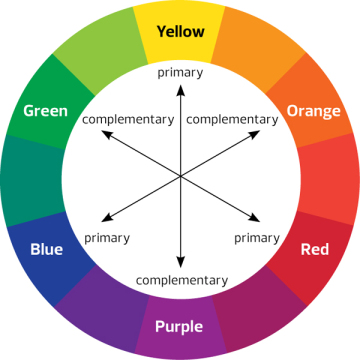Chances are if you’ve ever tried to paint a landscape, portrait or still life in watercolor, you’ve needed an arsenal of brown watercolor to depict your subject. All brands of watercolor paint sell a plethora of brown pigments, but did you know it’s super easy to mix your own using a basic primary color palette?

Let’s explore how to mix a beautiful array of earthy brown watercolor.
Most of us have a basic red, yellow and blue at our disposal, and that’s all we need to mix a wide variety of earthy umbers and siennas. Browns are basically what we achieve when we mix complementary colors in the right ratios.
A complementary color is what we get when we mix a primary color (red, yellow or blue) and its secondary color across the color wheel.
Complementary Colors:
- Red & Green
- Yellow & Violet
- Blue & Orange

When we mix a small amount of the secondary color with its complementary primary, we get a muted version of the primary. The more of the secondary that we mix in, the browner the primary will become, and eventually we will achieve black.
Let’s look at some examples of mixing brown with complementary colors.

Above, I’ve started with a neutral red (Quinacridone red in this case) and a warm blue (French Ultramarine) and mixed them together in equal parts to arrive at a very deep violet.
If I add violet’s complement — yellow (in this case a warm yellow, New Gamboge) — I will get a deep, rich brown watercolor, almost like a sepia. Pretty simple, yes?
What happen if we use other shades of red, yellow and blue?

Here I’ve started with a cool red (Quinacridone rose) and a warm blue (French Ultramarine) to arrive a bright violet color.
If I add a small amount of cool yellow (Lemon Yellow) I achieve a very warm, golden brown. If I add just a bit more Ultramarine to this mix I get a cooler, more taupey brown.
By adding more water to your mixes, you can achieve lighter hues, as opposed to the dark brown in the first example.
Another variation shows us how to achieve true Burnt Sienna and Burnt Umber hues.
This is a super easy, thrifty way to mix those two hues without having to buy more paint.

By mixing a warm red (Transparent Pyrrol Orange) with a warm yellow (New Gamboge), I achieve a glowing orange. By mixing a very small amount of orange’s complement — blue (in this case French Ultramarine) — I get a beautiful, glowing Burnt Sienna. If I add just a bit more blue, I arrive at a rich Burnt Umber.
Now, how about the easiest way to mix brown?
A warm red or red-orange pigment, such as Transparent Pyrrol Orange, is a mainstay on my palette. Because orange is the complement of blue, I can make a simple mix with warm red and a cool blue and arrive at an instant rich brown watercolor.

I chose a cool blue, such as Phthalocyanine Blue GS, because it has a bit more yellow in it, and matches perfectly with a warmer red to make this instant brown. Try it! And don’t stop there…
By adding just a touch of warm yellow to my instant brown, I can achieve a gorgeous chestnut hue.
Adding even more small increments of yellow will give you warmer tones of golden browns. By adding a bit more blue you can get cooler shade of chocolaty brown. Pretty simple, right?

One last little tip…
Another super easy brown mix is adding a Sap Green to a warm red. If you have Sap Green in your paint supply, try adding it any neutral to warm red and watch it transform into many shades of rich brown, depending on the ratios you use. Take a look!

So there you have it — several super simple ways ways to use your primary colors to mix a variety of beautiful brown watercolors. Experiment with these mixes, using more or less of each color and you will discover hundreds of hues right at the tip of your brush. Have fun!
Learn More Mixing Tricks from Kateri!
Join Kateri’s popular online painting class and say goodbye to mixing muddy watercolors! Learn how to use fundamental techniques and a limited palette to create all the beautiful hues you want.

wonderful simple tips on mixing browns - thank you!
I need color mixing exercises
So many wonderful colors from just six tubes of paint. I have learned so much about colors and had real fun at the same time from doing the lessons in Kateri's classes. I highly recommend them. Thanks Kateri.
Love your classes!